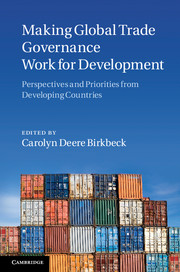 Making Global Trade Governance Work for Development
Making Global Trade Governance Work for Development Book contents
- Frontmatter
- Contents
- Figures
- Tables and boxes
- Contributors
- Acknowledgements
- Introduction
- Part I Global trade governance
- 1 Globalization, development and democracy
- 2 Trade, development and the UN Millennium Development Goals
- 3 The interactions of trade, macroeconomic policies and sustainability
- 4 Trade governance and sustainable development
- Part II Roles and responsibilities in global trade governance: diversity in developing country priorities and strategies
- Part III Strengthening multilateralism
- Part IV Making WTO negotiations and decision-making processes fairer
- Part V Conclusion
- Index
- References
4 - Trade governance and sustainable development
from Part I - Global trade governance
Published online by Cambridge University Press: 07 September 2011
- Frontmatter
- Contents
- Figures
- Tables and boxes
- Contributors
- Acknowledgements
- Introduction
- Part I Global trade governance
- 1 Globalization, development and democracy
- 2 Trade, development and the UN Millennium Development Goals
- 3 The interactions of trade, macroeconomic policies and sustainability
- 4 Trade governance and sustainable development
- Part II Roles and responsibilities in global trade governance: diversity in developing country priorities and strategies
- Part III Strengthening multilateralism
- Part IV Making WTO negotiations and decision-making processes fairer
- Part V Conclusion
- Index
- References
Summary
The fact that we need not go into great detail about what sustainable development is speaks volumes about how widespread the notion has become in policy-making and scholarly circles over the past two decades. Nor is it novel any longer to draw links between sustainable development and trade governance. It is now well understood that as international arrangements on trade expanded their reach ‘behind the border’ to establish contractual obligations covering non-tariff measures such as health and safety regulations, environmental policies, intellectual property protections and practices related to investment, they took on greater significance in national governments’ efforts to convert the opportunities presented by the globalized economy into sustainable development. The trade system has been transformed from a market-opening device into a rules-focused regime (Barton et al. 2008). Regulations for the global economy determine today the way resources are allocated and how they may be used, and thus define sustainable development possibilities.
But how do we get from where we are today to the ‘sustainability’ aspiration? Fortunately, we are not tasked with answering this. We focus our attention on the ‘trading system’ – a term that encompasses the multilateral regime embodied in the World Trade Organization (WTO) together with the growing landscape of bilateral and regional trade agreements and other preferential arrangements for economic integration. It is clear that new policies for governing investment, finance, energy and knowledge will be necessary to harness economic activity into modes of production that favour conserving resources over exhausting them. How is the trading system equipped to help steer economic activity towards the necessary pathways of change?
- Type
- Chapter
- Information
- Making Global Trade Governance Work for DevelopmentPerspectives and Priorities from Developing Countries, pp. 100 - 134Publisher: Cambridge University PressPrint publication year: 2011
References
- 1
- Cited by
